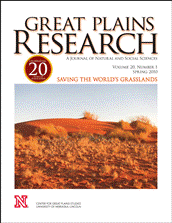Center for Great Plains Studies

Great Plains Research: A Journal of Natural and Social Sciences (through 2013)
Date of this Version
Spring 2007
Document Type
Article
Abstract
Quantifying evapotranspiration (ET) over vast ecosystems such as the Sandhills of Nebraska is crucial in linking the surface, subsurface, and atmospheric processes affecting a region. There are numerous methods of obtaining large-scale ET estimates, but most are constrained by the availability of data. This study investigates implementation of an approach that uses a simple land-cover-based standardized tall (ETrs) and short (ETas) surface reference crop evapotranspiration and crop coefficient to compute actual ET over various spatial and seasonal scales. Subsequently, computed ETrs was used to get the preliminary estimate of regional ET over the entire Sandhills at the 30 m scale by using Landsat vegetation data. Therefore, while the final ET values are a close approximation to actual ET, it does not relate to the real water consumption by the vegetation in the Sandhills. The 30 m ET values were aggregated at four different scales (500 m, 1 km, 5 km and 10 km) using three methods of interpolation (nearest neighbor, bilinear interpolation, and cubic convolution) in estimating coarser-scale ET. Although the differences in the estimated ET among these four resolutions and three interpolation methods were generally small in magnitude, aggregation resulted in a mean percentile error of up to 4% when compared with estimated high-resolution 30 m ET over the region. In general, both nearest neighbor and bilinear interpolation methods were found to perform better than the cubic convolution method.


Comments
Published in GREAT PLAINS RESEARCH 17:1, pages 35-45 (Spring 2007). Copyright © 2007 Center for Great Plains Studies, University of Nebraska–Lincoln.